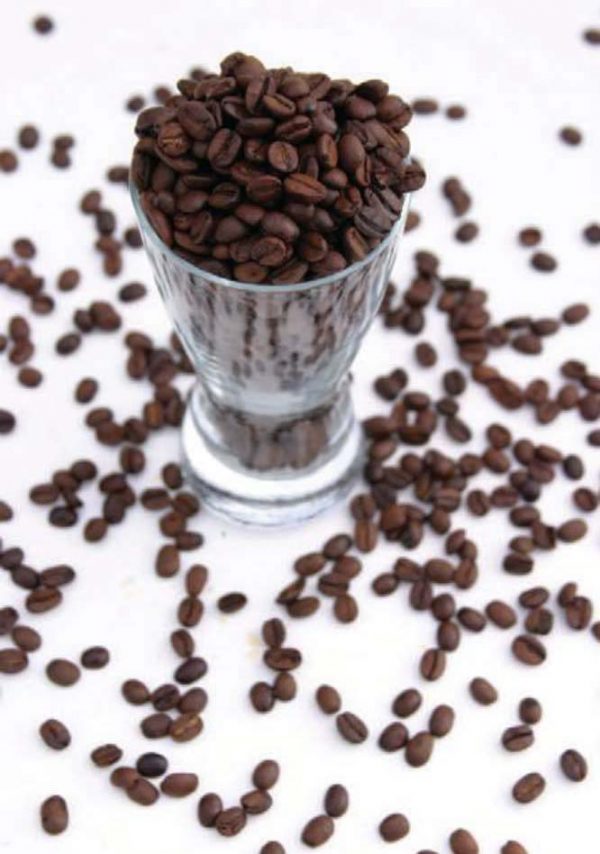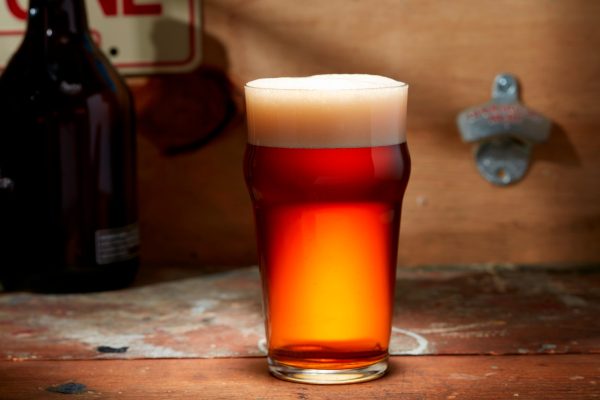
Originally published in the September/October 2012 issue of Zymurgy magazine.
Some things go together: bacon and eggs, thunder and lightning, hippies and sandals, and of course coffee and beer. Many coffee lovers are beer lovers, and vice versa. When well made, both beverages have great depth and complexity in addition to their simple, pleasing attributes. Blending them together can make a wonderful beer that is perfect for both socializing and contemplation.
As a professional brewer, I’m on a continual quest to make the perfect coffee beer. I have spent a great deal of time collaborating with different roasters and speaking with other brewers about how to properly approach coffee beer. In the process, I’ve created half a dozen commercially successful examples of the style. This article will describe what I’ve learned regarding the process and techniques for making great coffee beer.
Choosing the Beans
My preferred method focuses on the coffee first: I start by finding great coffee and gathering ideas for the beer by tasting it (or “cupping” as the coffee industry calls it). This approach can be challenging, but the end result can be very rewarding. Most brewers I talk with take the opposite approach. They start with a beer they’ve made, then find a suitable coffee. This method can also result in a great beer; just take the time to find a coffee that will properly complement your award-winning stout.
When it comes to finding coffee, talking with experts and seeking out your local roaster can reap rewards. Look for a local roaster who is knowledgeable and, importantly, produces coffee you enjoy. Like beer, the best coffee is often made in small batches, where care for the ingredients and process can be adjusted to suit the roaster’s desires.
Coffee quality and variety vary greatly depending on the coffee’s origin, the way it was processed, and the length and temperature of roasting. Coffee ‘s profile can range from the dry, spicy fruit character of a lightly roasted African variety, to the bold, rich chocolate flavors of French roast South American beans. Experiment and find a flavor profile that suits the kind of beer you want to make.
Don’t be afraid to blend coffees for a unique coffee profile. Buy cups of different coffees at a local shop (or use your French press at home) and mix them in different proportions. You may end up with something like 1/2 Mexican, 1/4 Sumatra, and 1/4 Ethiopian. Take notes and keep the ratios the same when measuring out the coffee for your beer.
Making a Coffee Toddy
- For 5 U.S. gallons (19.83 L) of beer
- Equipment
- 1 quart jar with lid, sanitized
- 2 muslin sacks, or pantyhose
- Ingredients
- 2 oz (57 g) of coffee ground to electric percolator (second from the coarsest) setting on commercial coffee grinder.
- 2 cups (473 mL) water
- Procedure
- 1. Place ground coffee into the doubled muslin sack or pantyhose inside jar, then stretch around the outside of the jar.
- 2. Fill with 1.5 cups (354 mL) cold water and put lid on tightly.
- 3. Leave in the refrigerator for 24 hours.
- 4. After 24 hours, open lid and lift out sack of coffee. Pour out remaining coffee toddy, ;eaving the dregs (last coffee bits) behind.
- 5. Add to secondary before transferring from your primary.
- 6. If you only have a primary, put the toddy in before bottling, or, if you keg, the Cornelius keg upon transfer.
- Important note: The ideal ratio of coffee to water is 1 oz (28 g) coffee to 8 fluid oz (237 mL) water.
Once you find the perfect coffee, it’s time to create the beer recipe. Porters and stouts are perfect for coffee beer because the deep chocolate and fruit flavors from the malt tend to lend themselves to coffee. However, it is possible to make a great lighter beer with coffee. One of my favorite breweries does a white coffee (very lightly roasted) saison. This fantastic saison uses its unique yeast with the light malt and coffee to create gentle nutty flavors, with a rich complexity of earth and spice.
If you are new to brewing coffee beer, it’s a good idea to keep the malt bill simple. As you progress in your brewing knowledge, you can make the recipe more complex.
Deconstructing Addicted Stout
The coffee I have chosen for Addicted Stout is a blend of French roast (deep chocolate flavors), Sumatra (bold nutty flavors), and Ethiopian (bright, spicy fruit, notes of blueberry, stone fruit) coffees.
The base malt is two-row pale malt, which has plenty of diastatic power to convert starches to sugars in the mash. This gives us a clean malt canvas to work with. Munich malt lends a small boost to the body of the beer and deepens the nutty malt flavor. Crystal 45L provides nice clean honey and light caramel flavors, complementing a darker crystal malt like Extra Dark Crystal 150L, which has notes of plums and dark cherry. Both provide more depth to the fruit and chocolate flavors of the coffee.
For the roasted malt, rich but airy roast emerges from roast barley, while black malt enhances the dark chocolate flavors and imparts darker head color. Chocolate malt is a subtle roasted malt that lends gentle cocoa notes. The malt bill is finished with Simpsons Brown (kilned much darker than traditional brown malt), the only malt l list by name because no other malt is quite like it. Simpsons Brown lends pleasant coffee flavor and deftly links the other dark malts to the delicate nuances of the coffee.
Hops are kept simple, at a balanced but dignified 20 IBU, keeping in mind that we will get just a little bitterness from the coffee. The first addition is Magnum, a high alpha hop perfect for efficient bittering. The other two additions are the American hop Crystal. Crystal is a fresh, mildly grassy hop great for providing a balanced hop background in malt forward beers. The flavor and aroma hop additions are low enough that they will not stand out, but will instead cut the sweetness of the malt. You can safely leave a flavor/aroma addition out if you prefer, but l enjoy just a touch of that grassiness in the final beer.
Addicted Coffee Stout Recipe
- Ingredients for 5 U.S. gallons (19.83 L) of beer:
- 10 lb (4.54 kg) two-row malt
- 1.25 (0.57 kg) Munich malt
- 5 oz (142 g) 45°L crystal malt
- 5 oz (142 g) 150°L crystal malt
- 4 oz (113 g) roast barley
- 4 oz (113 g) chocolate malt
- 4 oz (113 g) black malt
- 4 oz (113 g) Simpsons brown (coffee) malt
- 2 oz (57 g) coarse ground coffee (steep 2 minutes at knockout or add toddy* to secondary)
- 0.25 oz (7 g) Magnum hops, 14.5% a.a. (60 min)
- 0.5 oz (14 g) Crystal hops, 5% a.a. (30 min)
- 1 oz (28 g) Crystal hops, 5% a.a. (0 min)
- White Labs 001 or Wyeast 1056
- Directions:
- Mash at 151°F (66°C) for one hour. Ferment at 68°F (20°C) until finished.
- Original Gravity: 1.070
- IBUs: 20
- SRM: 38
- Brewhouse Efficiency: 75%
- Extract Version:
- Replace pale two-row malt with 7.5 lb (3.4 kg) pale malt syrup and Munich malt with 15 oz (425 g) Munich malt syrup. Steep the remaining grains in 160°F (71°C) water for half an hour. Strain, rinse grains, add extract, and dissolve thoroughly. Proceed with boil. Increase 60 min addition of Magnum to 0.5 oz (14 g).
Adding Coffee to Beer
There are two ways to properly add coffee to beer: before fermentation (hot side) or after fermentation (cold side).
Hot Side
This is the easier of the two methods. I’ve had a lot of good coffee beers made this way, adding ground coffee (French press setting on a commercial grinder) in a couple of muslin sacks doubled up and steeped in the wort at flame out. The key to success is not leaving the coffee beans in the hot wort for too long. No more than a few minutes of steeping are necessary. The longer the coffee beans are kept in, the more astringent (and unpleasant) the coffee flavor will become. If you want more coffee flavor, use more coffee, not a longer steeping time. Start with half a pound of your favorite coffee steeped for about two minutes. Remove it, then chill the wort and transfer into your fermenter.
Cold Side
This is the method I prefer and the one that many fine coffee shops use to make their iced coffees. I make what the coffee industry calls a toddy, which is basically cold-steeped coffee. The toddy is made by leaving coarsely ground coffee beans overnight in cold water, then removing the beans. This gives a smooth, rich coffee flavor with very little astringency. The toddy is typically added after fermentation to secondary.
These tips and the recipe provided will help get you started making good coffee beer. Be confident. Inspired beer comes from making the beer you want to drink. The best beer is always in your basement carboy, bubbling away.
Nathan Watkins was previously the head brewer for Southern Sun Pub and Brewery in Boulder, Colo. He has created beers that have won awards at the Great American Beer Festival and the World Beer Cup, including a silver medal for Addiction at the 2010 World Beer Cup.



Share Post